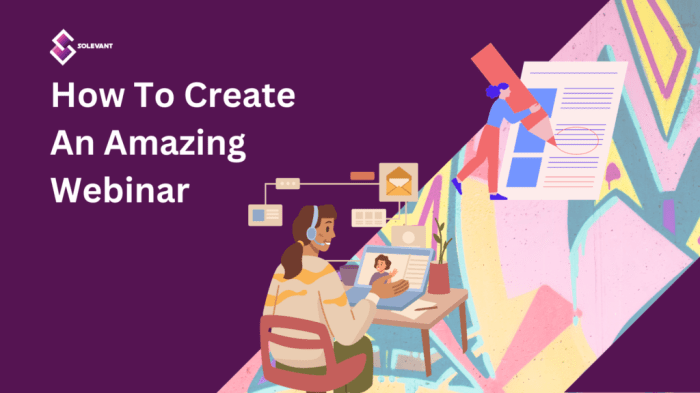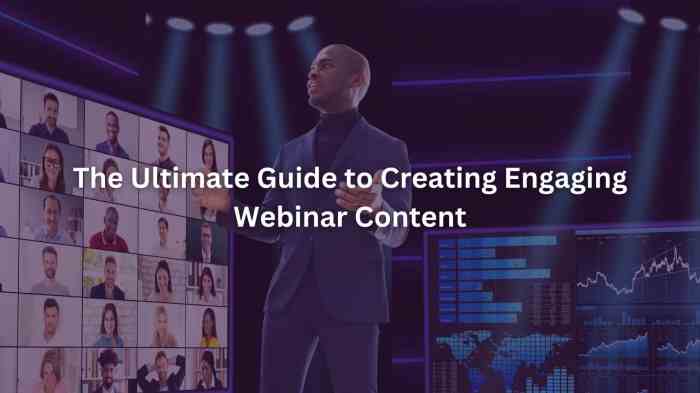Creating Engaging Webinars dives deep into the world of online presentations, offering a fresh take on captivating your audience and keeping them hooked until the very end. Get ready to revolutionize your webinar game with these game-changing strategies.
Whether you’re a seasoned pro or just starting out, this guide will equip you with the tools and knowledge to create webinars that leave a lasting impact.
Overview of Webinars

Webinars, short for web seminars, are online presentations, workshops, or lectures held in real-time over the internet. They allow businesses and individuals to connect with a large audience regardless of geographical location, making them a powerful tool in the digital age.
Successful Webinar Formats and Strategies
- Interview Style: Hosting industry experts or influencers for engaging discussions.
- Interactive Q&A Sessions: Encouraging audience participation and feedback.
- Live Demos and Case Studies: Demonstrating products or services in action for a hands-on experience.
- Educational Workshops: Providing valuable knowledge and skills to attendees.
Benefits of Hosting Webinars
- Increased Reach: Reaching a global audience without the limitations of physical events.
- Cost-Effective: Saving on venue, travel, and accommodation expenses associated with traditional events.
- Lead Generation: Capturing valuable leads through registration forms and engagement during the webinar.
- Establishing Authority: Positioning the host as an expert in their field and building credibility.
Planning Engaging Webinars
Planning engaging webinars is crucial to attract and retain participants. From selecting relevant topics to setting clear goals, each step plays a vital role in the success of your webinar.
Selecting Relevant Topics for Webinars
When choosing a topic for your webinar, consider the interests and needs of your target audience. Research trending topics in your industry and select a subject that will provide value to attendees. Make sure the topic is timely, relevant, and addresses a specific pain point or challenge your audience is facing.
- Research your target audience’s interests and needs.
- Choose trending topics in your industry.
- Select a subject that provides value and addresses a specific pain point.
Creating a Captivating Webinar Title and Description
The title and description of your webinar are the first things potential attendees will see, so it’s essential to make them captivating and compelling. Create a title that is clear, concise, and intriguing to grab the audience’s attention. The description should provide a brief overview of what participants can expect to learn and why they should attend.
- Keep the title clear, concise, and intriguing.
- Provide a brief overview of what participants can expect in the description.
- Highlight the value attendees will gain from the webinar.
Setting Clear Goals and Objectives for a Webinar
Setting clear goals and objectives for your webinar is essential to ensure that you stay focused and deliver valuable content to your audience. Define what you want to achieve with the webinar, whether it’s to educate, inform, or promote a product or service. Setting specific goals will help you structure the content and measure the success of your webinar.
- Define the purpose and objectives of the webinar.
- Set specific goals to guide the content and presentation.
- Measure the success of the webinar based on the defined goals.
Designing Interactive Content: Creating Engaging Webinars
Creating engaging webinars involves designing interactive content to keep participants actively involved throughout the session. By incorporating interactive elements like polls, quizzes, and Q&A sessions, you can make the webinar more dynamic and engaging for the audience. Additionally, incorporating multimedia elements like videos and slides can help break up the presentation and cater to different learning styles.
Polls and Quizzes
Using polls and quizzes during the webinar can help gauge participant understanding and keep them engaged. These interactive elements can also provide valuable feedback to the presenter on the effectiveness of the content being delivered. For example, you can ask participants to answer a poll question related to the topic being discussed or include a quick quiz to test their knowledge.
Q&A Sessions
Incorporating Q&A sessions throughout the webinar allows participants to ask questions in real-time and interact with the presenter. This not only fosters engagement but also helps clarify any confusion or address specific concerns that participants may have. Encouraging active participation in Q&A sessions can create a more interactive and personalized experience for attendees.
Multimedia Elements
Including multimedia elements like videos and slides can enhance the visual appeal of the webinar and cater to different learning preferences. Videos can be used to demonstrate concepts or showcase real-life examples, while slides can help summarize key points and keep participants focused. Integrating multimedia elements strategically throughout the presentation can make the content more engaging and memorable for participants.
Engaging Participants

To keep participants engaged during a webinar, it’s essential to create a dynamic and interactive environment. Encouraging audience interaction and participation can make the session more exciting and informative for everyone involved. Additionally, fostering a welcoming and inclusive atmosphere can help attendees feel comfortable and engaged throughout the webinar.
Managing Audience Interactions
- Encourage participants to ask questions throughout the webinar by utilizing a chat or Q&A feature.
- Respond to audience queries promptly and address their concerns to show that their input is valued.
- Include polls, surveys, or interactive quizzes to keep attendees actively involved and interested in the content.
Creating a Welcoming Environment
- Start the webinar with a friendly welcome message and introduction to set a positive tone for the session.
- Use inclusive language and avoid jargon or technical terms that may alienate certain participants.
- Encourage respect and open-mindedness among attendees to ensure a safe and welcoming space for all participants.
Promotion and Registration
To make sure your webinar is a hit, you gotta get the word out and get those registrations rollin’ in. Let’s dive into some key strategies for promoting your webinar and maximizing those sign-ups.
Promoting Through Various Channels
- Utilize social media platforms like Facebook, Twitter, and LinkedIn to reach a wider audience.
- Send out targeted email campaigns to your existing contacts and mailing list.
- Collaborate with industry influencers or partners to help spread the word.
- Consider paid advertising on platforms like Google Ads or social media to boost visibility.
Increasing Webinar Registrations, Creating Engaging Webinars
- Create a sense of urgency by highlighting limited spots or time-sensitive offers.
- Offer valuable incentives like free resources, discounts, or exclusive access to encourage sign-ups.
- Promote your webinar through guest blogging on relevant websites or industry publications.
- Host a pre-webinar teaser session or Q&A to generate interest and excitement.
Compelling Landing Pages and Registration Forms
- Design visually appealing landing pages that clearly Artikel the benefits and key takeaways of attending the webinar.
- Keep registration forms simple, asking for only essential information to reduce friction and increase conversions.
- Incorporate engaging visuals, testimonials, and social proof to build credibility and trust with potential participants.
- Add a clear call-to-action button that stands out and prompts visitors to register immediately.
Technical Considerations
When it comes to hosting a webinar, there are some important technical aspects to consider to ensure a smooth and successful event. From choosing the right platform to testing your equipment, internet connection, and software, these details can make a big difference in the overall experience for both you and your participants.
Webinar Platform Options
- Zoom: One of the most popular webinar platforms, offering features like screen sharing, breakout rooms, and webinar recording.
- GoToWebinar: Known for its reliability and ease of use, with features such as polls, Q&A, and analytics.
- Webex: Offers interactive features like whiteboarding, file sharing, and integration with other apps.
- Microsoft Teams: Ideal for businesses already using Microsoft products, with features like chat, file sharing, and live captions.
Tips for Testing Equipment and Connection
- Test your microphone and camera to ensure clear audio and video quality.
- Check your internet connection speed to prevent any lag or disruptions during the webinar.
- Run a practice webinar to familiarize yourself with the platform and troubleshoot any issues beforehand.
